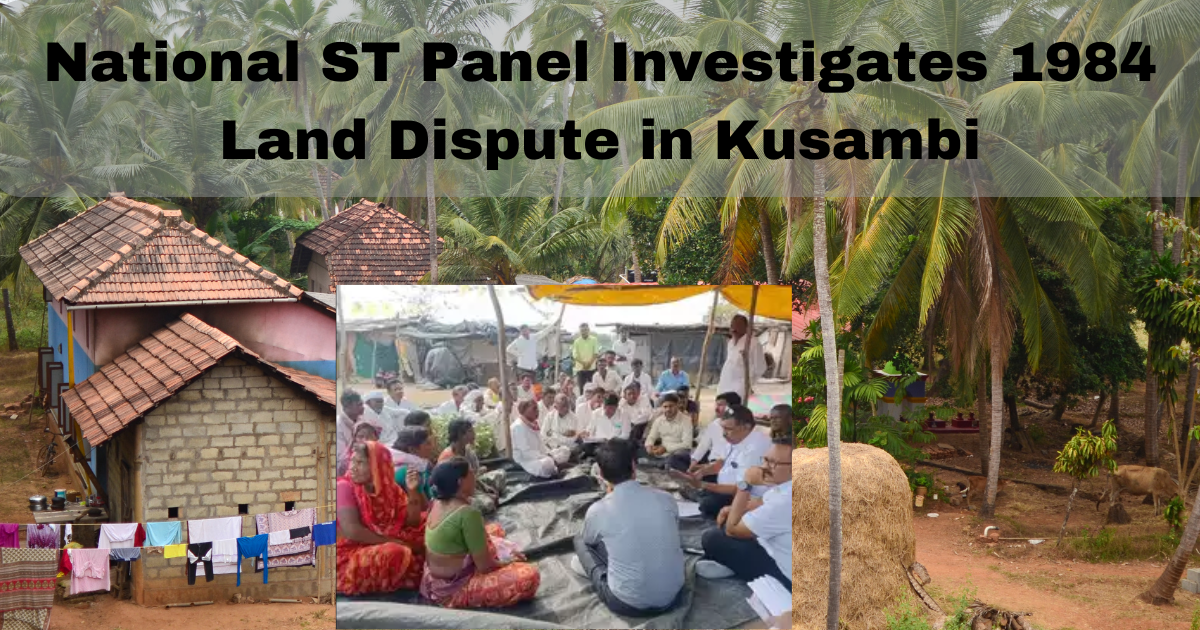National ST Panel Investigates 1984 Land Dispute in Kusambi: Chandrapur: Social activists Vinod Kharagade and Bhaarat Atram submitted documents before the investigation team to support the villager’s claims” They have been living in distress for decades due to the loss of their land to limestone mining”
National ST Panel Investigates 1984 Land Dispute in Kusambi
Chandrapur: A two-member team from the National Commission for Scheduled Tribes (NCST) visited Kusambi village in Jiwti taluka on Wednesday to investigate allegations by 24 tribal families of illegal acquisition of their agricultural land by Manikgarh Cement Company in 1984. The villagers claim They have been living in distress for decades due to the loss of their land to limestone mining. The company was initially granted a 20-year lease in 1979 for limestone mining on 643 hectares of forest land, with two subsequent extensions of 30 years each.

The affected tribal families allege that their land adjacent to the mine was taken over in 1984 without compensation. “We are deprived of basic amenities such as electricity, water, healthcare, and education. Women walk 2 km daily to fetch water, and the nearest hospital is 10 km away. The villagers claimed that “Our children have grown up without schooling” said Anandrao, Meshram, a resident. He further claimed that stone blasting in the mines poses a constant risk to the remaining villagers, forcing many youths to migrate in search of low-applying jobs.
The investigation
After multiple failed attempts to seek justice through administrative and legal channels, the villagers of Kusambi approached the National Commission for Scheduled Tribes (NCST) through social activist Vuinod Khobragade. Following three hearings, NCST ( National Commission for Scheduled Tribes) deputed a special team, comprising Amrutal Prajapati and Gowardhan Munde, to assess the situation on the ground. The team, accompanied by local officials, recorded the statements of the affected villagers.
While company representatives and the administration claim that compensation of Rs12,500 per acre was paid in 1984, the villagers refute the claim, alleging that the land possession documents presented by the company are fabricated.
Hiraman Ude, an illiterate villager, recounted how he worked as a watchman at the mine in the 1980s for two years. “They took my thumb impression on the document claiming it was a salary slip. Now. they present those as my consent for land transfer,” he alleged. Other villagers also denied signing or providing a thumb impression on any compensation-related documents.
Land Acquisition
Social activities Vinod Khobragade and Bharat Atram submitted documents before the investigating team to support the villagers` claims. “The company insists it paid compensation, but the records provided contain names of individuals from Nokari and pandit Guda, not Kusambi, ” said Khobragade.
The villagers have demanded compensation of Rs.2 crore per acre, rehabilitation, resettlement, and employment for one member of each affected family. The villagers claim They have been living in distress for decades due to the loss of their land to limestone mining.
Manikgarh Cement assistant general manager Naveenkumar Kaushik told TOI that the company had already disbursed over Rs9 lakh in compensation through the administration in 1983-84. He also stated that the high court had dismissed a petition filed by the villagers, affirming that compensation was provided. Furthermore, he claimed the government had rehabilitated the villagers and allocated compensatory land.
With conflicting claims from both sides, the NCST (National Commission for Scheduled Tribes) investigation is expected to determine the villager’s rights and the company`s legal standing in the matter. In Dharampur village of Kaushambi development block. voting remained affected in the morning but later, district officers managed to convince voters to exercise their franchise. A section of locals upset over poor amenities in their villages threatened to boycott polling in the Khaushambi district. Last year in December, the locals protested in Kaeli for several days.
The district court Kaushambi
The district court Kaushambi was established at district headquarters Manjhanpur on Oct.13, 2000, and Shri Jagat Prakash was the District and sessions judge, earlier the jurisdiction access to justice for citizens living in outlying and remote areas. The Anganwadi building that the district administration had provided at Manjhanpur for the operation of the courts was inaugurated by the Chief Justice of Allahabad High Court, Hon`ble Shri Shyamal Kumar Sen in the presence of Hon’ble Shri Vinod Kumar Rai Administrative Judge High Court, Allahabad on October 13, 2000.
